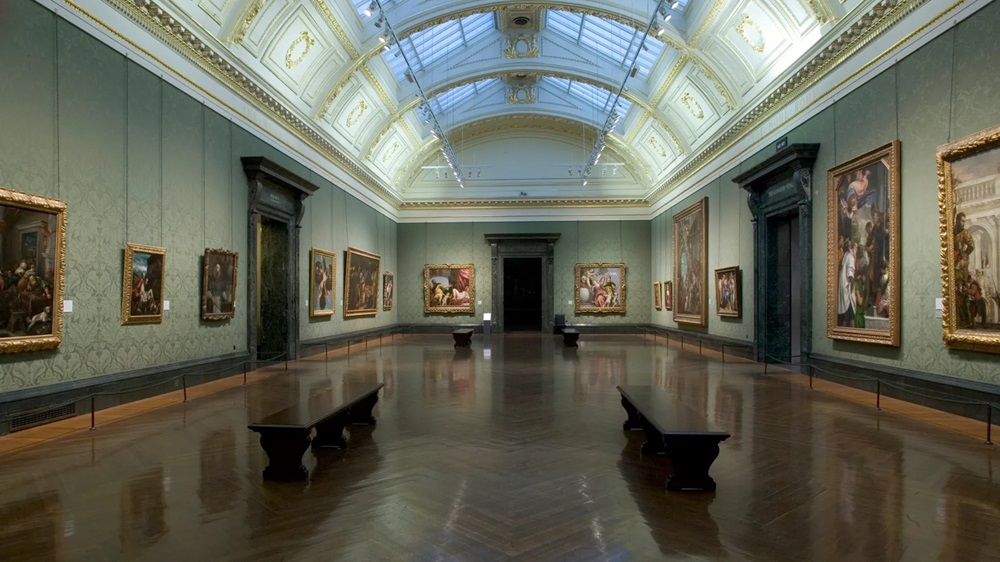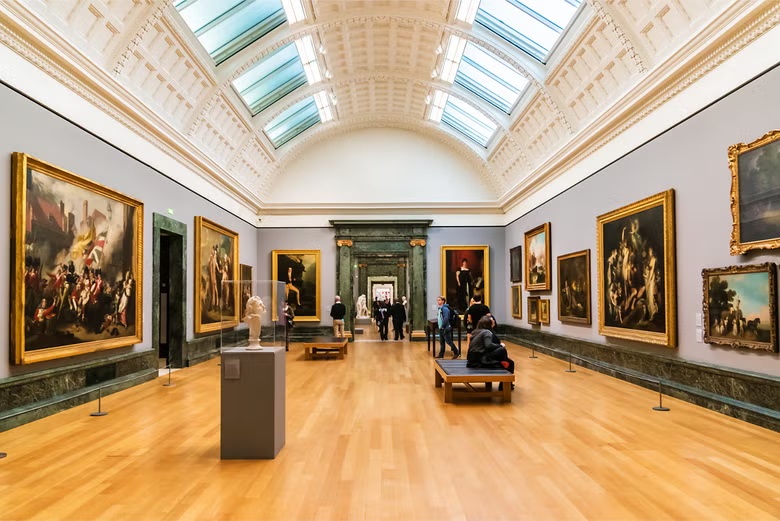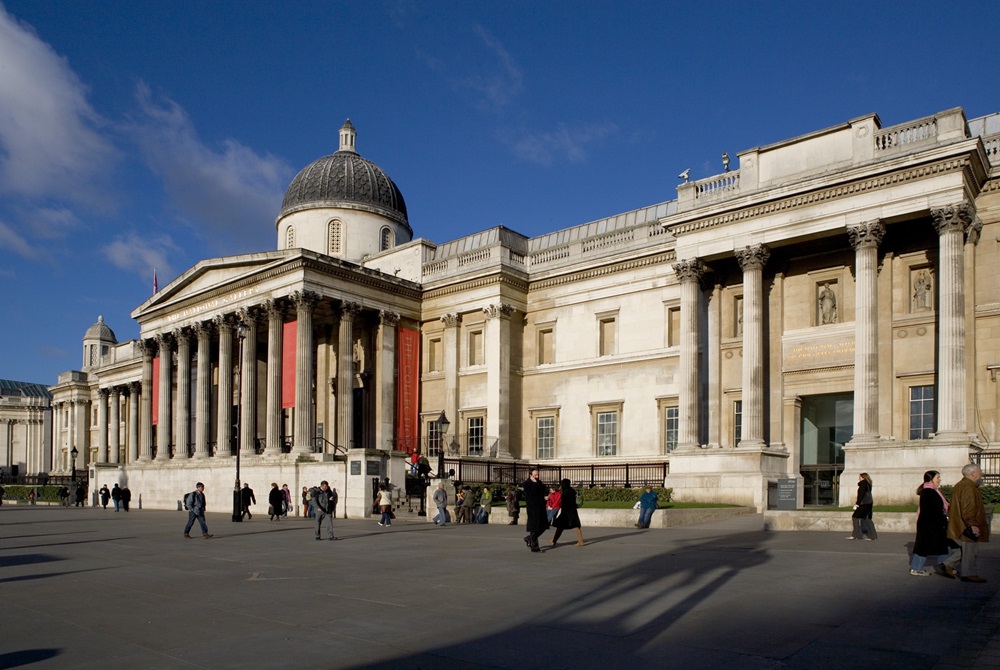The National Gallery in London is an iconic art museum located in Trafalgar Square. Its collection has more than 2,300 artworks, dating from the middle of the 13th century to the 1900s. Masterworks by well-known painters like Michelangelo, Claude Monet, Rembrandt, Leonardo da Vinci, and Vincent van Gogh are among those in the collection.
The gallery is a must-visit for tourists and art fans because it is free to enter and accessible to everyone. The National Gallery often holds temporary exhibitions, talks, workshops, and other art and art history events in addition to its permanent collection. It is a centre of culture and an essential component of London’s history and identity.
History of the National Gallery of London
The London National Gallery has a long history that began in the early 1800s. It was established in 1824 when the estate of banker John Julius Angerstein sold 38 paintings to the British government. These first purchases served as the foundation for the gallery’s collection. The government viewed the acquisition of these artworks as a way to create a national public art gallery.
The collection soon outgrew its first home, Angerstein’s former townhouse on Pall Mall. After William Wilkins won an architectural competition, the gallery relocated to its current home in Trafalgar Square in 1831. The main structure of the National Gallery is still the Neoclassical architecture planned by Wilkins, despite many additions and modifications throughout the years. By acquisitions, gifts, and bequests, the National Gallery has progressively increased the size of its collection over time. The gallery has received essential contributions from notable patrons and collectors, including Sir George Beaumont, Baron Ferdinand de Rothschild, and Sir Hugh Lane. The gallery has also purchased many treasures through negotiations and private sales.
The National Gallery is well-known for its extensive collection of paintings from Western Europe and has grown to become one of the top art museums in the world over time. It has also been essential in increasing art education and scholarship, providing audiences of all ages and backgrounds via programmes, talks, and exhibitions. Millions of tourists visit the National Gallery annually, symbolising Britain’s dedication to the arts and rich cultural legacy.

‘Ever since its conception in 1824, the ‘much-loved friend’ in Trafalgar Square has been part of national life to an extent unmatched by any other great museum. Established, housed and maintained directly by their representatives in parliament, the British Gallery was always owned by the people. And they exercised their ownership rights in ways that could surprise and confound the Trustees and staff charged with the Gallery’s administration: from Victorian working-class matrons enjoying gin-fuelled picnics to the postwar teenagers who made Trafalgar Square their ‘snogging shop’. While the site gave the Gallery a ring-side seat on some of the most violent political demonstrations of modern times, its location at the heart of the capital also made it a place of refuge in times of national crisis – and never more so than during World War II, when thousands of Londoners thronged the famous one-picture shows and free concerts organized by Kenneth Clark. Extensive new research reveals the close personal and often highly political interest taken in the Gallery’s affairs by the Trustees, who included many well-known figures, from Sir Robert Peel and William Ewart Gladstone through Curzon and John Maynard Keynes to Noel Annan and Isaiah Berlin. But its phenomenal success in becoming a national symbol also made the Gallery a tempting target for those seeking political change – from the Suffragette who slashed Velazquez’s Rokeby Venus in 1914 to the Birmingham man who stole Goya’s Wellington in 1961. The first history of the Gallery ever published, “The Nation’s Mantelpiece”, traces the development of an institution whose superlative collections often set the pace in art history but whose dependence on parliamentary funding regularly implicated it in debates surrounding education, social cohesion and national heritage. The story of the Gallery’s paintings offers an intriguing opportunity to follow the changes in taste and connoisseurship that have helped create the Old Master canon we know today. The building has been a test of taste, and its carbuncle-strewn history also receives unprecedentedly close attention, writes Jonathan Conlin in his book, ‘The Nation’s Mantelpiece: The History of the National Gallery’.
Art Collection of National Gallery of London
According to the gallery’s official website, the businessman and collector John Julius Angerstein created the first paintings in the National Gallery collection. They included exquisite Dutch, Flemish, English school pieces and Italian pieces such as The Raising of Lazarus, a sizable altarpiece by Sebastiano del Piombo. Sir George Beaumont (1753–1827), a landscape painter and art collector, pledged in 1823 to give the country access to his collection of paintings, provided that enough space could be made available for their preservation and exhibition.

According to the National Gallery London website, The late Prime Minister Sir Robert Peel’s collection of 77 Dutch and Flemish artists, such as Hobbema’s The Avenue at Middleharnis paintings, was purchased by the Gallery in 1871, adding even more artwork to its collection. The National Gallery received the largest-ever donation of artwork in the form of J.M.W. Turner’s Bequest. Discover the fascinating tale of how these significant paintings were acquired and displayed. Many of his paintings, such as “Dido building Carthage” and “Sun Rising through Vapour,” were left to the country after his death. Works ‘Landscape with the Marriage of Isaac and Rebecca’ and ‘Seaport with the Embarkation of the Queen of Sheba’ by Claude were included with the requirement that these two works be shown beside each other.
The National Gallery of London will begin a bicentennial celebration on May 10, 2024, marking 200 years of connecting people with paintings. For the entire year, the gallery honours the past. Setting the tone for our third century, it looks forward to the future with a year-long festival of art, innovation, and imagination.
British Museum Announces Ambitious Plan to Digitize Entire Collection





